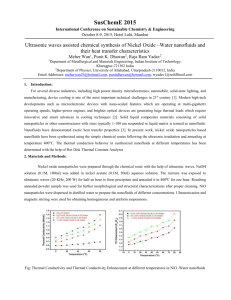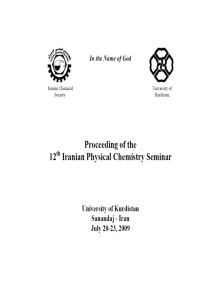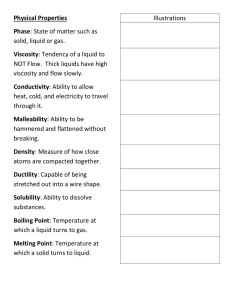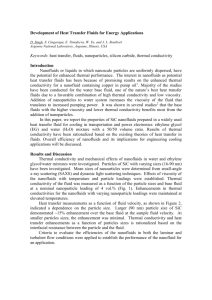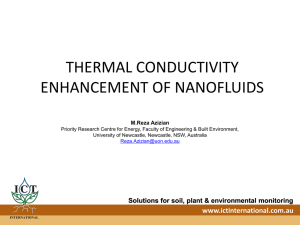View Full Paper
advertisement
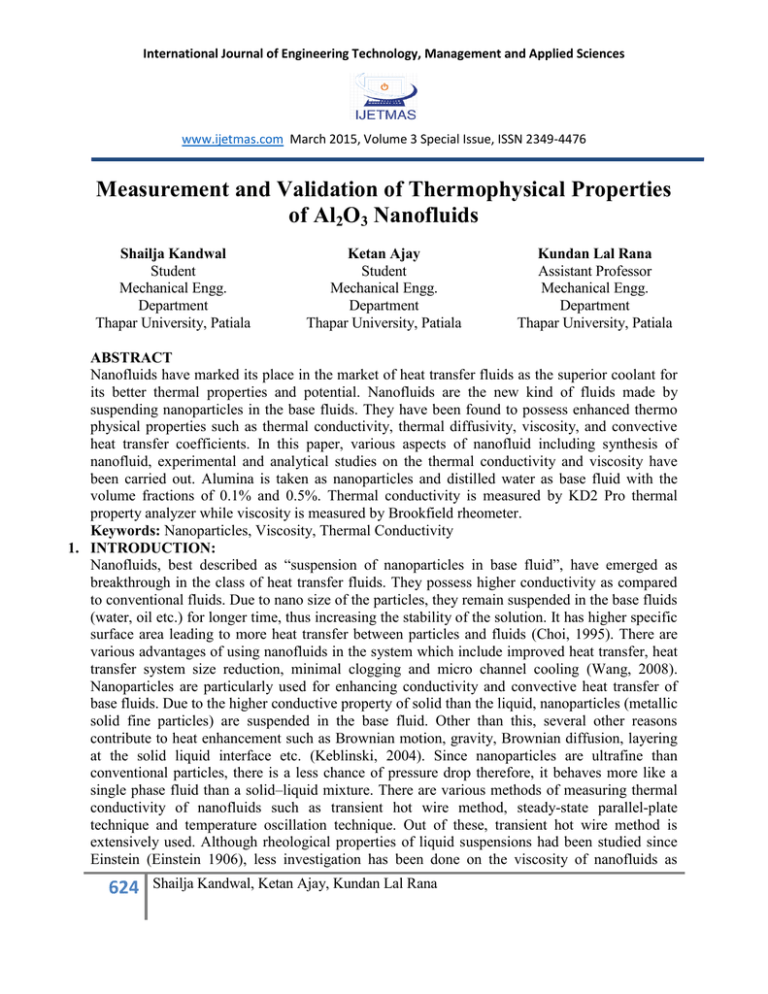
International Journal of Engineering Technology, Management and Applied Sciences www.ijetmas.com March 2015, Volume 3 Special Issue, ISSN 2349-4476 Measurement and Validation of Thermophysical Properties of Al2O3 Nanofluids Shailja Kandwal Student Mechanical Engg. Department Thapar University, Patiala Ketan Ajay Student Mechanical Engg. Department Thapar University, Patiala Kundan Lal Rana Assistant Professor Mechanical Engg. Department Thapar University, Patiala ABSTRACT Nanofluids have marked its place in the market of heat transfer fluids as the superior coolant for its better thermal properties and potential. Nanofluids are the new kind of fluids made by suspending nanoparticles in the base fluids. They have been found to possess enhanced thermo physical properties such as thermal conductivity, thermal diffusivity, viscosity, and convective heat transfer coefficients. In this paper, various aspects of nanofluid including synthesis of nanofluid, experimental and analytical studies on the thermal conductivity and viscosity have been carried out. Alumina is taken as nanoparticles and distilled water as base fluid with the volume fractions of 0.1% and 0.5%. Thermal conductivity is measured by KD2 Pro thermal property analyzer while viscosity is measured by Brookfield rheometer. Keywords: Nanoparticles, Viscosity, Thermal Conductivity 1. INTRODUCTION: Nanofluids, best described as “suspension of nanoparticles in base fluid”, have emerged as breakthrough in the class of heat transfer fluids. They possess higher conductivity as compared to conventional fluids. Due to nano size of the particles, they remain suspended in the base fluids (water, oil etc.) for longer time, thus increasing the stability of the solution. It has higher specific surface area leading to more heat transfer between particles and fluids (Choi, 1995). There are various advantages of using nanofluids in the system which include improved heat transfer, heat transfer system size reduction, minimal clogging and micro channel cooling (Wang, 2008). Nanoparticles are particularly used for enhancing conductivity and convective heat transfer of base fluids. Due to the higher conductive property of solid than the liquid, nanoparticles (metallic solid fine particles) are suspended in the base fluid. Other than this, several other reasons contribute to heat enhancement such as Brownian motion, gravity, Brownian diffusion, layering at the solid liquid interface etc. (Keblinski, 2004). Since nanoparticles are ultrafine than conventional particles, there is a less chance of pressure drop therefore, it behaves more like a single phase fluid than a solid–liquid mixture. There are various methods of measuring thermal conductivity of nanofluids such as transient hot wire method, steady-state parallel-plate technique and temperature oscillation technique. Out of these, transient hot wire method is extensively used. Although rheological properties of liquid suspensions had been studied since Einstein (Einstein 1906), less investigation has been done on the viscosity of nanofluids as 624 Shailja Kandwal, Ketan Ajay, Kundan Lal Rana International Journal of Engineering Technology, Management and Applied Sciences www.ijetmas.com March 2015, Volume 3 Special Issue, ISSN 2349-4476 compared to thermal conductivity. In today’s advanced tech-savvy era, cooling technology comes with a critical importance that controls the performance of industrial, automobile and medical devices and systems as the lack of proper vent-out of heat could limit the performance of the system. The conventional approach for augmenting heat dissipation is to increase the surface area but this approach requires an undesirable increase in the system’s size. Therefore, nanofluids- a novel concept of heat transfer fluids- comes into play to meet these challenges (Pawel Keblinski, 2005) 2. PREPARATION OF NANOFLUIDS: Nanofluids are extensively prepared by two methods, one-step method and two-step method. In one-step process, nanoparticles are made by different methods and dispersed, simultaneously, in the base fluid. This process helps in minimizing the agglomeration of particles by eliminating the processes of drying, storage, transportation and dispersion of nanoparticles and thus increasing the stability of fluids (Y. Li, “A review on development of nanofluid preparation and characterization", 2009) . The only drawback of this process is that this method doesn’t produce nanofluids in large scale and is expensive as well. Two-step method is the most widely used and economic method for synthesizing nanofluids in large scale. It comprise of two processes: one, making of dry powders by chemical or physical methods and second, dispersing into a fluid with the help of ultrasonic agitation, high-shear mixing, homogenizing and ball-milling (Granqvist, 1996). Stability is a matter of concern in this method because high surface area and surface activity of nanoparticles make it to aggregate and form clumps. So, to enhance the stability of nanoparticles, surfactants can be used (Xie, 2009). In the present work, alumina (Al2O3) as nanoparticle and distilled water as base fluid has been used for making nanofluid. No surfactant was used during the preparation. Two volume fractions are taken: 0.1% and 0.5% while the size of alumina is 40-45 nm. First step should be to weigh the exact amount of alumina nanoparticles as per volume fractions with the help of digital weighing balance machine. Next step is to pour the measured amount of nanoparticles into the 50 ml distilled water jar in such a way that nanoparticles do not stick on the wall of jar. After this, put the jar in the ultra sonicator for atleat 2-3 hours for uniform dispersion. 3. EXPERIMENT: 3.1. Measurement of Thermal conductivity: Thermal conductivity is measured by using KD2 pro thermal properties analyzer.KD2 pro issupplied by Decagon Devices, Inc. 2365 NE Hopkins Ct. Pullman, WA 99163 USA. It is a portable, hand-held device and battery-operated. There are two types of sensors present in it. 625 Fig1: KD2 Pro Shailja Kandwal, Ketan Ajay, Kundan Lal Rana International Journal of Engineering Technology, Management and Applied Sciences www.ijetmas.com March 2015, Volume 3 Special Issue, ISSN 2349-4476 The single needle sensors measure thermal conductivity and resistivity while the dual needle sensors measures diffusivity and volumetric specific heat capacity. KD2 Pro is 5% accurate over the 5°C- 40°C temperature range. It consists of sensor needles and a hand-held microcontroller. As in present work, only KS-1 (single needle) sensor is used which helps in minimizing the problem of free convection by adding a small amount of heat to the sample during measurement. The KS-1 sensor needle measures thermal conductivity of fluids in the range of 0.2-2 W/mK. This needle contains both a heating element and a thermistor. Each measurement cycle consists of 90s. During the first 30s, the instrument will equilibrate and afterwards, for every 30s, sensor needle will be heated and cooled. At the end of the reading, thermal conductivity is computed by the controller using Where q=constant heat rate applied to an infinitely long and small line source. In this work, the whole process is done for base fluid i.e distilled water and next, the same process is repeated for nanofluid. First, take a fluken tube, pour the sample into it and place it in the stand. Then, with the cello-tape, put the KD2 Pro KS1 sensor needle in the sample inside fluken tube. Afterward put this whole setup in the water bath and wait for the steady state. Readings are taken from 30°C to 60°C as above 60°C, KD2 Pro produces large errors. 3.2. Measurement of Viscosity: For the measurement of viscosity of nanofluids, Brookfield rheometer has been used. It consists of cup and cone shape structure and a spindle immersed in the nanofluid. Spindle is driven by the rheometer. A viscous drag of the fluid is developed against the spindle, when it is being rotated in the fluid. This viscous drag is further measured by the deflection of calibrated spring. Fig 2: Brookfield rheometer 4. RESULTS AND DISCUSSIONS: 4.1. Variation of thermal conductivity with concentration of nanoparticles The thermal conductivity of nanofluids increases with the increase in temperature at a particular concentration of nanoparticles. At a particular temperature, the thermal conductivity increases with increase in concentration of nanoparticle. At 0.1% of concentration, when nanoparticles are mixed with distilled water, increase in thermal conductivity is very small. The thermal conductivity of distilled water and nanofluid at 0.1% concentration is almost same up to 500C temperature. 626 Shailja Kandwal, Ketan Ajay, Kundan Lal Rana International Journal of Engineering Technology, Management and Applied Sciences www.ijetmas.com March 2015, Volume 3 Special Issue, ISSN 2349-4476 Fig 3: Thermal Conductivity vs Temperature 4.2. Variation of viscosity with concentration From the experimental data plotted on the graph, the viscosity decreases with increase in temperature. Viscosity also increases with the increase in concentration of nanoparticles. Higher the concentration of nanoparticles, higher is the viscosity of the nanofluids at a particular temperature. There is a normal increase in the viscosity of the nanofluids at 0.1% conc. of nanoparticles, above 550C. Fig 4: Viscosity vs Temperature 4.3. Validation of Experimental data with Maxwell and Jeffery Model for thermal conductivity Thermal conductivity measured by Maxwell model can be expressed as: 627 Shailja Kandwal, Ketan Ajay, Kundan Lal Rana International Journal of Engineering Technology, Management and Applied Sciences www.ijetmas.com March 2015, Volume 3 Special Issue, ISSN 2349-4476 Where; Keff = Thermal Conductivity of solid / liquid (Al2O3) Km = Thermal Conductivity of base fluid (Distilled water), K2 = Thermal Conductivity of nanoparticle 𝑣 = Particle volume fractions (1% and 0.5%), α = K2/Km Thermal conductivity measured by Jeffery model can be expressed as: Keff = Thermal Conductivity of solid / liquid (Al2O3) Km = Thermal Conductivity of base fluid (Distilled water), K2 = (Thermal conductivity of Alumina nanoparticle from data), 𝑣 = Particle volume fractions (0.1% and 0.5%), α = K2/Km β = (α-1) / (α+2) Fig 5: Comparison of Experimental Thermal Conductivity with Maxwell and Jeffery Model at 0.1% concentration The experiment values of thermal conductivity are compared with the values obtained from the Jeffery and Maxwell model. It has been seen that both the models predict almost same values of thermal conductivity. The predicted values are found less as compared to experimental values. The model prediction suits better only for low concentration like 0.1%. As the concentration increases, the difference between experimental and predicted values increase. It can be inferred that the models have under-predicted the conductivity values. 628 Shailja Kandwal, Ketan Ajay, Kundan Lal Rana International Journal of Engineering Technology, Management and Applied Sciences www.ijetmas.com March 2015, Volume 3 Special Issue, ISSN 2349-4476 Fig 6: Comparison of Experimental Thermal Conductivity with Maxwell and Jeffery Model at 0.5% concentration 4.4. Validation of experimental data with Brinkman and Einstein Model for Viscosity Viscosity of nanofluids can be measured by Brinkman Model which is expressed as: Where. = Viscosity of nanofluid (Al2O3), = Viscosity of base fluid (Distilled water) = Particle of volume fraction 0.1% and 0.5% Viscosity of nanofluids can be calculated by Einstein Model as follows: Where, = Viscosity of nanofluid (Al2O3), = Viscosity of base fluid (Distilled water) = Particle of volume fraction 0.1% and 0.5% The values of viscosity obtained experimentally are compared with the values obtained from the Brinkman model and Einstein model. At a particular concentration of nanoparticles, both the above models gives the same value of viscosity for the nanofluids. It is found that the experimental values are always greater than the values obtained from the models but at low concentration of nanoparticles such as 0.1%, the value of viscosity above 550C are almost same. Fig 7: Comparison of Experimental Viscosity with Einstein and Brinkman Model at 0.1% concentration 629 Shailja Kandwal, Ketan Ajay, Kundan Lal Rana International Journal of Engineering Technology, Management and Applied Sciences www.ijetmas.com March 2015, Volume 3 Special Issue, ISSN 2349-4476 For 0.5% conc. of nanoparticles, the experimental values of viscosity of nanofluids are always higher than the predicted values from the models. 5. 1. 2. 3. 4. 5. 6. 7. Fig 8: Comparison of Experimental Viscosity with Einstein and Brinkman Model at 0.5% concentration CONCLUSION: Thermal conductivity and viscosity values are obtained by experiments using different concentrations of nanoparticles and theoretically validated these results with different models. Following conclusions were made: Thermal conductivity of distilled water and nanofluids increases with the increase in temperature. With the increase in concentration of the nanoparticles, thermal conductivity of the nanofluids also increases at a particular temperature. On adding 0.5% con of nanoparticles, thermal conductivity is enhanced by 8.5% at 56˚C. The viscosity of the distilled water and nanofluid decreases with increase in the temperature. At a particular temperature, with addition of the nanoparticles, the viscosity of the base fluid increases. At 31˚C, the enhancement of viscosity is approximately 14% with addition of 0.5 % conc. of nanoparticles. The values obtained from models for both thermal conductivity and viscosity have almost similar values. At low conc. of nanoparticles, the values obtained from the models are almost same as that of the values obtained experimentally but as the conc. get increased from 0.1 to 0.5% conc., values obtained from the Maxwell and Jeffery models are under-predicted. The models used for the validation of viscosity are also under predicted i.e. at a higher conc., values obtained from the models are much lesser than the experimental values. 630 Shailja Kandwal, Ketan Ajay, Kundan Lal Rana International Journal of Engineering Technology, Management and Applied Sciences www.ijetmas.com March 2015, Volume 3 Special Issue, ISSN 2349-4476 REFERENCES: [1] Choi, S. U. (1995). Enhancing thermal conductivity of fluids with nanoparticles. ASME newyork , pp. 99–105. [2] Choi, S. U. S. (2009). Nanofluids: From Vision to Reality through Research. ASME Journal of Heat Transfer, vol. 131, no. 3, pp. 033106-1–033106-9. [3] BIBLIOGRAPHY \l 1033 C. T. Nguyen, G. R. (August, 2006). Heat transfer enhancement by using Al2O3-water nanofluid in a liquid cooling system for microprocessors. Proceedings of the 4th WSEAS International Conference on Heat Transfer, Thermal Engineering and Environment, (pp. pp. 103–108). Elounda, Greece. [4] G. Paul, M. C. (2010). Techniques for measuring the thermal conductivity of nanofluids: a review. Renewable and Sustainable Energy Reviews , vol. 14, p. 1913. [5] Granqvist, C. G. ( 1996). Ultrafine metal particles. Journal of Applied Physics , vol 47. pp. 220. [6] Keblinski, P. C. (2004). Encyclopedia of Nanoscience and Nanotechnology. Retrieved from American scientific publishers: http://www.aspbs.com/enn/ [7] Lee, J.-H. H. (2008). Effective viscosities and thermal conductivities of aqueous nanofluids containing low volume. International Journal of Heat and Mass Transfer , vol. 51, no. 11-12, pp. 2651-2656. [8] Li, C. H. (2006). Experimental investigation of temperature and volume fraction variations on the effective thermal conductivity of nanoparticle suspensions (nanofluids). Journal of Applied Physics , vol. 99, no. 8, 084314-1–084314-8. [10] Pawel Keblinski, J. A. (2005, june). Nanofluids for thermal transport. materialstoday , pp. 36-44. [11] S.U.S., C. (2009). Nanofluids: From vision to reality through research. ASME journal of heat transfer , vol 131, no.3, pp 033106-1-033106-9. [12] Wang, X. Q. (2008). A review on nanofluids - part II: Experiments and applications. Brazilian Journal of Chemical Engineering , vol. 25. pp. 631 - 648. [13] BIBLIOGRAPHY \l 1033 Wang, L. a. (2010). Nanofluids Research: Key Issues. Nanoscale Research Letters , vol 5. no. 8, pp. 1241–1252,. [14] W. Yu, D. M. (2010). Mechanisms and models of effectivethermal conductivities of nanofluids. Journal of Nanoscience and Nanotechnology , vol. 10, no. 8, pp. 4824–4849. [15] Xie, W. Y. (2009). A Review on Nanofluids: Preparation, Stability Mechanisms, and Applications. science direct , pages 89-101. [16]Y. Li, J. Z. (2009). “A review on development of nanofluid preparation and characterization". science direct , 89–101. 631 Shailja Kandwal, Ketan Ajay, Kundan Lal Rana
